You may not realise it, but all the food you eat has been genetically altered over time by plant and animal breeders, capturing advantageous traits to grow more nutritious and easy-to-farm foods as efficiently and healthily as possible. Maize, or corn as it's often know, is a prime example of this change. Plus, is attractiveness to mosquitoes in your genes? And our gene of the month is small but significant.
In this episode
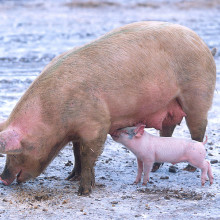
01:22 - DJ de Koning - Spring meeting overview
DJ de Koning - Spring meeting overview
with DJ de Koning, Swedish University of Agricultural Sciences
Kat - This month I'm reporting back from the Genetics Society Spring meeting - Breeding for bacon, biofuels and beer - which was held up at the Roslin Institute in Edinburgh last month. Over two days we heard fascinating talks from a range of researchers working on ways to make the plants and animals that we eat more efficient, healthy and sustainable, in order to deal with the challenge of feeding an ever-growing global population in a changing climate. I caught up with one of the organisers, DJ de Koning from the Swedish University of Agricultural Sciences, to find out more about the idea behind the meeting.
DJ - So, there's been a lot of developments in both plant and animal breeding regarding the use of genomic and genetic technologies over the last 5, 10 years that is both the use of really huge molecular marker sets, and so, tens of thousands or hundreds of thousands of DNA markers or even whole genome sequences, but also the technologies in gene editing - so modifying these on a much larger scale than previously thought possible. People discussed a lot in meetings within their own species or within crops or within livestock. It is very rarely that we have a meeting where these experts come together and we can talk across species and have some sort of cross-fertilisation.
Kat - Appropriate term! Tell me about some of the talks that we've heard so far.
DJ - Jack Dekkers gave a really good introduction to the area from a livestock perspective. This is what we call genomic selection where we use tens of thousands of markers to do our selection of best animals for the next generation yesterday. We finished off today with an amazing talk by our Mendel lecturer, John Doebley. He gave a beautiful introduction also first of all of the history of domestication of maize from teosinte and combined top notch science with improving agricultural production. That is also one of the big challenges we have now is, with the population keeps to grow, we need to feed them and all of this is combining to that.
Kat - The talks we heard yesterday, that was all about the changes that have been brought about through conventional breeding - selecting animals or plants that have interesting characteristics and breeding them. It was amazing to see how much change, just from conventional breeding, that people have managed to bring about in species that we know and love and eat. But then this morning, we had talks that are taking it to the next level. Tell me about that.
DJ - Yes. This morning, there were several talks about genetic modification, how we can change individual genes or bring in genes and this has been happening in plants and livestock for decades already. But with the new technologies like CRISPR and TALEN, this can be done in a much more efficient way. Especially for livestock, these techniques have been discussed for a long time, like GM chickens and GM pigs. But to do it at a scale that you could actually consider having this as commercial production was always deemed unfeasible because of the inefficiencies. One other highlight is the talk from Sweden from Li-Hua Zhu where she introduced how we use traditional selection and genome editing to domesticate an entirely new crop which I find, personally, highly exciting.
Kat - Painting a picture of what the future might be like, bringing together conventional breeding, bringing together gene technology, gene sequencing, genome editing, can you almost imagine what some of the foods that we eat, how those species might change, say, in the next 50 years? What would be your vision of the future of how some of these technologies come together?
DJ - That is a really good question. Of course, first of all, we have to develop the technology and then we have to implement it and get it accepted. So, the key question for how the future will look is whether gene editing is treated differently by the regulatory framework and the consumer perception as gene modification, because with gene editing we do a very precise change and we don't bring in genes from a completely different species as was done in the past. So, how it could look, I think the systems could become more specialised, but a lot of that specialisation will happen at the breeding company level. So, what I would hope is that at the farm level and the retail level, we can offer a more uniform, responsibly grown product that people can enjoy eating. And so, we know that we need to produce more food with less input and all of these technologies have their role to play in that.
Kat - You mentioned some of the public attitudes to things like genetic modification and gene editing. Do you think that is maybe the biggest challenge to get people to accept eating foods that have had these changes made to them?
DJ - I think it is a misconception that we simply need to educate the public. I think the public is smarter than we take them for and I think some research has shown that giving people more information only strengthens them in their opinion regardless of whether they were for or against GM food. But I think we have to show and justify it - and the other problem is that because of the cost of the regulations, the GM produce has been driven in the hands of the really big biotech companies that already have a negative perception themselves with the general public. So, if we can do things more from involving the consumers along the way, I think we have to develop and follow the market better and develop products or animals or crops where consumers see there is a justified way. It's not helping the companies make a profit - which is a valid reason in their own right because companies need to employ people - but also, it does help us to produce more sustainably. I think then we can get this message across.
Kat - So overall, if you could sum up the feeling that you've got from people presenting, the conversations that have been going on: what's the general feeling in the world of animal and plant breeding for our food - our bacon, our beer, our biofuels, our bread?
DJ - I think that at the technological level, we are all very excited and we really see good opportunities to increase food production over the next 5 years, 15 years. To make that a reality, we have to engage the industry stakeholders and the retail market. But I think from this meeting, I think there is an overall sense of optimism, how we can now combine these techniques for a more sustainable food production.
Kat - That was DJ de Koning from the Swedish University of Agricultural Sciences.
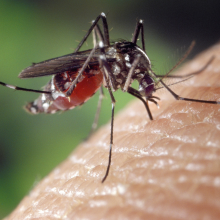
08:36 - James Logan - Tasty genes for mosquitoes
James Logan - Tasty genes for mosquitoes
with James Logan, LSHTM
Kat - As we head towards the summer, we've got some news that might be useful if you're heading off on vacation to a tropical destination. Holidays can easily be ruined by the misery of mosquito bites, as well as the risk of catching serious diseases such as malaria or dengue fever. But could attractiveness to mossies be in our genes? James Logan, from the London School of Hygiene and Tropical Medicine, has been finding out.
James - So, to test how attractive you are, we use an olfactometer - a Y-shaped tube essentially, which allows us to place volunteers' hands inside the tube and we test the response of the mosquitoes to odours from volunteers' hands. So, if mosquitoes are attracted to the hands, they will fly towards them. If they're not attracted, they'll fly away. So, in our study, we study twins essentially, and we looked at the behaviour of mosquitoes to the orders of identical and non-identical twins.
Kat - Because identical twins should have pretty much matching genes whereas non-identical twins are as alike as brother and sister.
James - That's exactly right, yeah. So, the idea is that if there is some sort of genetic control going on, we'd be able to see that in the behaviour of the mosquitoes. So, the hypothesis was that identical twins would be similar in their level of attractiveness and non-identical twins would be different.
Kat - I'm a bit concerned that you're getting volunteers to shove their hands in a tube full of mosquitoes. Are they going to get bitten?
James - Well, in this particular experiment, the volunteers don't get bitten. There is a mesh between the mosquitoes and their hands so they don't actually get bitten. But I have to say, we do other experiments where people get do bitten and they're pretty happy to do it.
Kat - It sounds crazy, but regardless of whether they did or didn't get bitten, what did you find when you wafted these mosquitoes towards the different people's hands?
James - In our test we looked at about 40 sets of twins. What we found in our experiment was that mosquitoes were equally attracted to odours from identical twins. When we subjected them to odours from non-identical twins, that correlation wasn't there. so, what that told us was that identical twins were similar in their level of attractiveness to mosquitoes which suggests that there is some sort of genetic control of how attractive you are to mosquitoes.
Kat - We hear a lot in the media about genes controlling things like our height, our IQ, our risk of diseases. How does this sort of level of attractiveness to mossies compare?
James - When we do this experiment, we have to do a calculation for heritability and that gives us a value between nought and one. The values that we got were quite high, astonishingly high actually, quite surprising. Really at the sort of level of the same sort of values you would get for IQ and height. So, it really was quite surprising. It seems to be very strong sort of genetic component.
Kat - We also know things like high IQ, they're not necessarily just one gene. Is it that there's a gene for attractiveness to mosquitoes and some people have one version or another, or is it going to be more complicated than that?
James - At this stage, we don't know. So, we know that there's something going on genetically. The next stage of the study is then to identify the genes involved. There could be more than one gene that probably is more than one gene involved. We know that mosquitoes respond to odours and how attractive you are is determined by the odours that you produce. These odours can be produced in different ways. They might be produced by the body itself. It might be produced via the skin bacteria which can also be influenced by your genetics. So, there's a lot of unanswered questions here, but it's really exciting, now that we can go on to the next stage and look at the genes.
Kat - So, once you do find these gene or genes that might be involved, what's the plan? Is it just to be able to test someone go bad luck, maybe don't go on holiday somewhere where there's mosquitoes?
James - I mean, that is something that we could think about. I mean, you can have your genome screened for all sorts of things nowadays and that could be one of the things that we look at, your susceptibility to being bitten by mosquitoes. That has more serious implications for populations in disease-endemic countries where malaria or dengue is a problem for example. So, we could look at the risk of certain populations and take into account how likely they are to be bitten when we do predictive modelling. But more than that, we could possibly develop a new technology. So, you might imagine taking a pill when you go on a holiday which causes the body to naturally upregulate the production of these natural repellents which is what make us unattractive and that would minimise the need for putting topical repellents on the skin.
Kat - There's a lot of sort of folklore and old wives' tales about maybe you should eat garlic or drink different things to repel mosquitoes. Is there any truth in that, now we're getting towards the summer holiday season?
James - It would be good if there was. A lot of people have various anecdotes about Guinness, is one of them, or gin, garlic, vitamin B. the truth is, there is no evidence that it can make you less attracted to mosquitoes. In fact, studies have been done which have shown that vitamin B for example has no effect on how attractive you are to mosquitoes. One study in 2010 showed that if you drank beer, it made you more attractive. So, take that advice as you will. I'm not sure whether that stops people drinking beer when they go on a holiday, but the difference wasn't very big, so I wouldn't be too worried about it.
Kat - I'm happy to risk it... James Logan there from the London School of Hygiene and Tropical Medicine.

13:43 - What do you want to know?
What do you want to know?
Regular listeners may remember the Genomethics survey I mentioned in a recent podcast. Led by Anna Middleton, it's designed to discover public attitudes towards genetic testing. Now the first results are in, with 98 per cent of the 7,000 people from 75 different countries who've taken the survey so far saying that they want to be informed if researchers looking at their genetic data find gene faults or variations linked to serious preventable or treatable disease. However, fewer wanted to know if their genomes revealed information about less serious conditions, or had currently uncertain consequences for their health.
This is important because while scientists have identified many genetic markers for certain diseases, just carrying a particular gene fault or variation linked to a particular condition isn't a guarantee that you'll develop it. there's still much about our genes and genomes that we don't understand, let alone be able to use to benefit people's health. But studies like the Genomethics survey help to reveal public attitudes to genetics research, which will help scientists and policymakers ensure that their plans fit with what the public want.
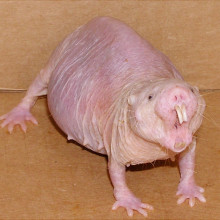
14:52 - Unique naked mole rat gene
Unique naked mole rat gene
Not only are naked mole rats known for their distinctive looks - best described as a 'wrinkly sausage with teeth' - they're also famous for the fact that they are strongly resistant to developing cancer, unlike all other mammals. This unusual trait stems from the exceptionally large amounts of a sticky molecule produced by the rats' cells, known as hyaluronan.
To figure out why the naked mole rats have this super-power, researchers at Queen Mary University of London studied the gene responsible for making hyaluronan, known as HAS2, in thirteen different species of mammals. They found that the naked mole rat's HAS2 gene seems to be completely unique to them, differing significantly even from other closely-related mole rats.
The scientists hope that identifying the crucial genetic differences between the HAS2 gene in different species will shed light on the processes underlying the development of cancer, and even point towards ways to prevent tumours from forming in the first place.
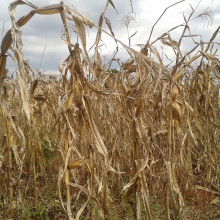
16:04 - John Doebley - The story of maize
John Doebley - The story of maize
with John Doebley, University of Wisconsin-Madison
Now it’s time to hear from John Doebley, the winner of this year’s Genetics Society Mendel Medal. As DJ mentioned earlier, he’s been finding out how thousands of years of selective breeding have changed teosinte - a plant with just a handful tiny, rock-like kernels - into the large seed-packed ears of maize, or corn, that we know today...
John - Maize is a crop plant that is native to the new world. It was grown by native American people, from Chile all the way up to Canada - in the Amazon jungle, it was grown in the desert, so the south western United States and the high mountains of the Andes and the high mountains of Mexico. So, it’s a very broadly adapted grain crop that was the major food source for many native American societies.
Kat - Tell me about the history of maize. Where did it first come from?
John - So, what we’ve learned over the past several decades is that maize was domesticated in south western Mexico, southwest of Mexico city. It probably was first domesticated about 10,000 years ago by native American peoples. After that initial domestication, it spread all the way south into south America, and all the way north as far as Canada.
Kat - So, this was farmers going, “Ooh! That looks good. Let’s grow that” or “That looks better. Let’s grow some more of those.”
John - I think that’s how the process worked. These were very observant people. They were excellent naturalists. They knew plants inside and out. The way I like to put it is if you took most modern people in highly industrial societies like the UK or the United States and you let them go in nature, they would starve within a week. But these people back then could probably collect in just a few weeks enough grain crop to last them all year.
Kat - Tell me about the ancestor of maize, this plant teosinte. What did that look like and what was the journey that took it to becoming maize?
John - Teosinte looks a bit like maize. It’s a very large plant. It can be 10 up to 15 feet tall. So, you can think of it like a wheat plant, but 5, 6 times bigger. However, it doesn’t have one big ear or two big ears. It has dozens and dozens of just tiny little ears, each of those tiny little ears having maybe only 10 kernels. And so, the architecture of the plant is rather different. It’s very branched and not like maize which typically has just one giant stalk.
Kat - What genetic changes do we know must've happened to turn those plants with their rock hard little seeds into lovely corn?
John - We know a bit of the story. Of course, we don’t know the whole story. One of the changes we’re aware of is controlled by a specific gene that takes the many little ears of teosinte and blocks them from forming and instead, replaces them with one rather large ear. And so, that change has a big effect on the number of ears on the plant. One large ear could have a lot more kernels than the many small ears in teosinte. The logic behind having that change is, if you think about it, if you are someone needing to harvest grain from a plant, would you want to pick 50 tiny little ears off the plant, each with 10 kernels, or would you rather pick just one ear with 500 kernels?
Kat - I'm kind of lazy so I'm going to go for the one.
John - Exactly. And so, they selected for that change to make the plant easier to harvest.
Kat - What about some of the other genetic changes that have happened? Are they all similar things that humans have said, “That looks useful. Let’s go with that”?
John - Yeah, it’s exactly like that. Another one is there's another gene that’s involved in the manufacture of the casing around the teosinte kernels. That gene was changed so that those casings no longer form and the kernels are naked or uncovered on the ear. And that makes the grain much easier to eat because it’s a different – it’s as if a walnut, instead of having a hard shell around it was just sitting right there ready to eat.
Kat - Are these just single genetic changes we’re talking about with some traits particularly in humans, it’s many, many changes that make one variation, and these are just single changes that have wrought this very big change in the plant?
John - So, it’s a mix. So, in turning teosinte into corn, there are some of these genes that have single, very large effects on the way the plant looks, but then there are also many other genes with smaller effects. So, it’s a combination of the two and it is in a way very similar to many traits that are different between different human populations. Things like eye colour have a few genes that have very large effects and then some other genes with smaller effects as well.
Kat - And would all these kind of changes have been just kicking about in the teosinte plants for a native American to spot and go, “There it is” and just start growing that one?
John - Yes. I think it probably largely works something like that. So, teosinte is a plant that grows in enormous numbers in Mexico. It’s just millions and millions of plants growing over the landscape. They're each genetically different from the next one, just the same as people are each genetically different. And so, they could spot one that was having some desirable traits and use that one to grow the next generation.
Kat - And so, this is just random variations, random fluctuations in the teosinte genome that we’ve managed to capture and keep going for many, many years.
John - That’s right. As in any genome, there's a process of mutation in which errors are introduced – each generation there are a few things that don’t work quite right. For the most part, those mutations are destructive and interfere with the ability of the plant to survive and do its job. But occasionally, one of those mutations is useful. What people were doing was spotting the useful mutations and encouraging them to make their crop.
Kat - Do you think people realise when they look at maize on their plate or a sweetcorn and think, “This is a pretty mutant plant”?
John - I'm hesitant to guess what people think. Probably, most people don’t think that deeply about the food that they eat, unfortunately. If you want a really mutant, think about cauliflower. If you look at cauliflower, that plant has a hard time surviving on its own and really, it’s highly dependent because it doesn’t actually make good flowers. It just makes this mass of tissue that wanted to be a flower, but was disrupted.
Kat - Where is your work taking you next?
John - So, I mentioned one of the experiments I've been trying to do and that is to see if we can, in a sense, redomesticate teosinte. So, we’ve started with just taking a large number of teosinte plants, growing them in a field, and just like the ancient agriculturalists, picking up the ones that look the best. Then using those, start the next generation and want to do that over several generations and see how far along we can move from teosinte in a maize-like direction by applying artificial selection the same way that ancient peoples may have done.
Kat - So, they did that over maybe 8,000 to 10,000 years? How long do you reckon?
John - I'm not going to be around that long and so, I’ll be happy to do it just for about 10 years and see how far I get. I've already identified a younger colleague who’s just starting his career. He and I are going to work together on this. And so, he can take on the project when I retire.
Kat - John Doebley, from the University of Wisconsin-Madison.
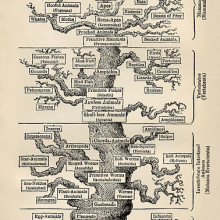
24:27 - James Rosindell - Tree of Life
James Rosindell - Tree of Life
with James Rosindell, Imperial College
Kat - It may be a bit too early in the year for music festivals, but it's always the right time for a science festival. This month I went along to the Imperial College festival to check out a fantastic range of exhibitions and events covering everything from quantum physics to infertility. One stand that caught my eye had a big computer screen covered with a spiralling, interactive tree of life. I asked its developer, James Rosindell, to walk me through it at the rather noisy launch event.
James - This is a visualisation of life on Earth and how it's related through evolution. So, we've got amphibians, mammals at the top, and then reptiles to the right, and birds underneath. You need to think of this as being rather like a map. So, you can zoom into an area and see further details. So, zoom in and then you start to see...
Kat - We've got some monkeys, old world monkeys, apes, and humans, tarsiers, lemurs, primates... there we go, flying lemurs, tree shrews...
James - Okay, well I'll show you the path to humans. So, if we start from the top, these are tetrapods. That means four feet and that includes the amphibians, mammals, reptiles and birds. There's a lot more life than that on the planet of course, but if we zoom in on mammals first of all, now we see the these details appearing. And within those, we can see primates. So, we're amongst them. We can see our sisters - rodents, dormice...
Kat - And we've got bats and I believe those up there, there's armadillos - my favourite animals. Where do we go from here?
James - Let's go to armadillos then if they're favourite because I actually also love armadillos. So, let's just go here. now, you may or may not have known that an armadillo is actually quite closely related to ant eaters and sloths. Together, they're a closely related group.
Kat - Are all these relationships, they're worked out by looking at the genetics of the animals and how closely they're related?
James - Yes, they are. Although there are some relationships in here that have been guessed based on the naming of the species. So, if we just look at the armadillo, as you can see it actually, a lot of people would think that an armadillo is just one species but in fact, there are 20 species of armadillo in here, including some very weird sounding ones like the screaming hairy armadillo, the large hairy armadillo, and...
Kat - So, there's the great fairy armadillo! That is super cool.
James - Unfortunately, we don't have an image of that one.
Kat - So, how does making trees like this, whether they're beautifully displayed like this or the kind of things that scientists might look at, how does this help us understand the diversity of life that's on this planet?
James - Well, from a perspective of a scientist, you can collect all these amazing data and you might be able to analyse it with a computer. But if you can't get it into your human brain to think about it then you miss out on using that intuition to notice patterns. So, as a scientist, I think it's important to be able to visualise your data in order to find out what's going on. But I think there's another greater use for this which is to show the general public and also, as an educational tour, the marvellous diversity of life on Earth, how it's related. And also, because the colours here corresponds to extinction risk - how much risk from extinction many of these species are.
Kat - Is this available online for people to play with and explore?
James - Yes, absolutely. it's available at the website www.onezoom.org and we're about to launch another version of it which enables people to build their own family trees to see their more closer relatives and that's at www.zoompast.org. That will be coming to you very soon.
Kat - James Rosindell, from Imperial College.
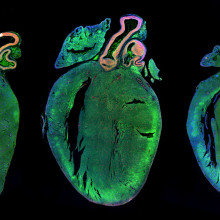
28:20 - Gene of the Month - Sarcolamban
Gene of the Month - Sarcolamban
with Kat Arney
And finally, it's our Gene of the Month, and this time it's Sarcolamban. A relatively new addition to the list of fruit fly genes, Sarcolamban gets a mention because of its unusual size - it's much, much smaller than regular genes, and one of thousands of so-called smORFs, or small open reading frames, scattered throughout the genomes of many organisms. For a long time it was unknown exactly what - if anything - these smORFs do, but the tiny proteins that they encode are now being discovered to play all kinds of important roles in cells.
Sarcolamban itself makes two little proteins, known as peptides, that are important for keeping flies tiny hearts beating regularly, and a similar gene has been found in humans. So, as with so many things in life, size doesn't always matter.










Comments
Add a comment